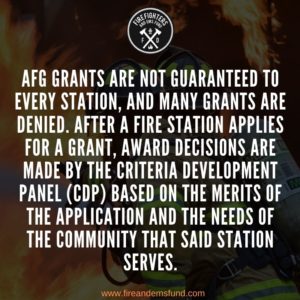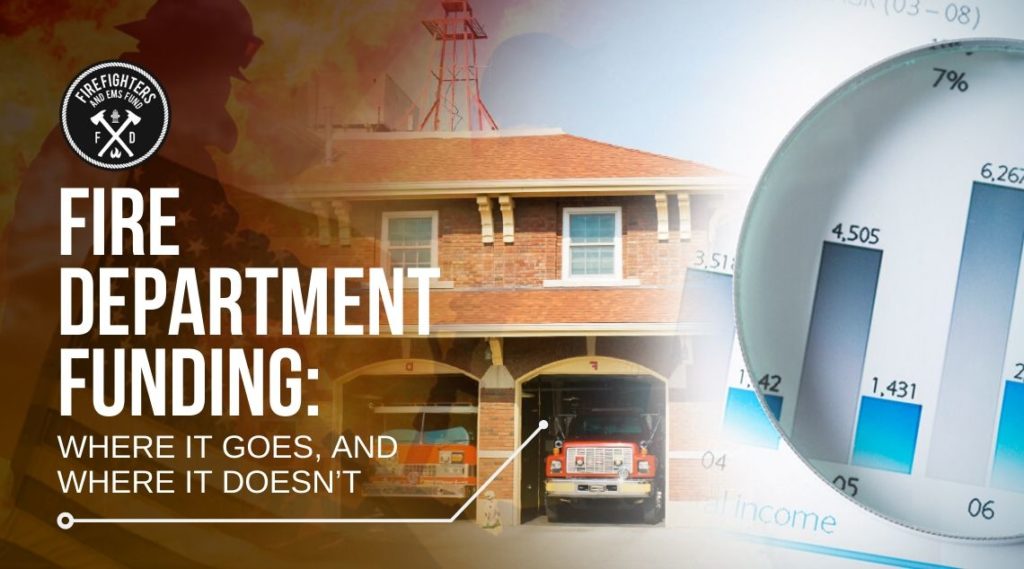Fire departments and emergency medical services (EMS) fulfill invaluable duties to their communities. In the United States, EMS agencies and fire departments respond to millions of calls for service each year. And at a time when emergencies like natural disasters, acts of terrorism, and hazardous material spills are steadily on the incline, government budgets are stretched increasingly thin. This means more duties for firefighters, with fewer dollars to support them. More so now than ever, fire departments must source income from places other than state and local governments, who are typically responsible for fire departments. Enter the fire grant. One of the most well known grant programs is the Assistance to Firefighters Grant or AFG.
The AFG was established in 2001 by the National Defense Authorization Act. According to the 2019 Congressional report on the distribution of fire grant funding, the program provides federal grants directly to local fire departments and unaffiliated Emergency Medical Services (EMS) organizations to help address a variety of equipment, training, and other firefighter-related and EMS needs. The AFG also supports fire prevention projects and firefighter health and safety research and development through the Firefighter Prevention and Safety (FP&S) grant program.
AFG assistance is distributed to career, volunteer, combination, and paid-on-call fire departments serving urban, suburban, and rural areas. For many stations across the United States, the AFG is what keeps station lights on, fully staffed, and ready to respond to emergencies.


However, AFG grants are not guaranteed to every station, and many grants are denied. After a fire station applies for a grant, award decisions are made by the Criteria Development Panel (CDP) based on the merits of the application and the needs of the community that said station serves. Congress must approve the budget for AFG on an annual basis and unfortunately, all too often it fluctuates without warning. Each year after congressional approval is received, the Federal Emergency Management Agency (FEMA) convenes a panel of fire service professionals to develop funding priorities for the AFG program. Funding priorities and criteria for evaluating AFG applications are established by FEMA based on the recommendations from the panel. The panel also helps to develop criteria for awarding grants. Factors like the degree to which an award will reduce deaths, the number of fire or medical emergencies calls by an applicant, or the extent to which a grant will protect the United States as a whole are taken into consideration.
After grants have been distributed, there is a specific and set list of purposes for which fire grant money can be used. According to Congress’s report, this includes training firefighting personnel, acquiring firefighting vehicles, modifying fire stations, educating the public about arson prevention, and more activities. FEMA also has the discretion to decide which of those purposes will be funded for a given grant year, and is subject to change annually. Since the program’s inception in 2001, the majority of fire grant funding has been used to replace or update trucks, personal protective equipment, and other physical fire fighting equipment.
While the AFG offers station-saving resources, the program is not without faults. Unfortunately, there is no set geographical formula for the distribution of fire grants. They also aren’t distributed based on number of emergencies, or degree of need. According to the Firefighters Support Alliance, grants are distributed largely due to population size, and the number of stations in each state. California and New York, two of the most populous states, were each awarded over $15 million in grants in 2017. These states have 3,332 and 2,297 departments, respectively. Meanwhile, Wyoming and Utah, two sparsely populated regions with significantly less stations, only received around $500 thousand. However, the Midwest has more fire and medical emergencies than both California and New York, making the distribution of grants uneven, and not always properly utilized. Rural America has long been known to be at higher risk for fire and life safety threats. Poverty, adult smokers, people living with disabilities, and being over the age of 80 are risk factors associated with increased fire and medical emergencies, and are more common in rural than urban areas. Unfortunately, rural regions still receive less grants than more populated cities. These stations have a harder time retaining a full-time staff, which means longer response time to emergencies, and more incidents of civilian death.
The AFG provides life-saving resources for thousands of fire departments in need across the United States. By offering financial assistance, the program helps fire departments replace aging equipment, keep stations staffed, and educate the public on fire safety. Unfortunately, even with grants, many stations in less populated regions are still left with major gaps in their annual budget. The Firefighter and EMS Fund works closely with local governments in order to raise public awareness on this issue, and get legislation passed that would allow for additional funding to stations across the US.
Do you know a station that’s struggling to serve its community due to lack of financing? Reach out our executive director Nile at nile@fireandemsfund.com.









